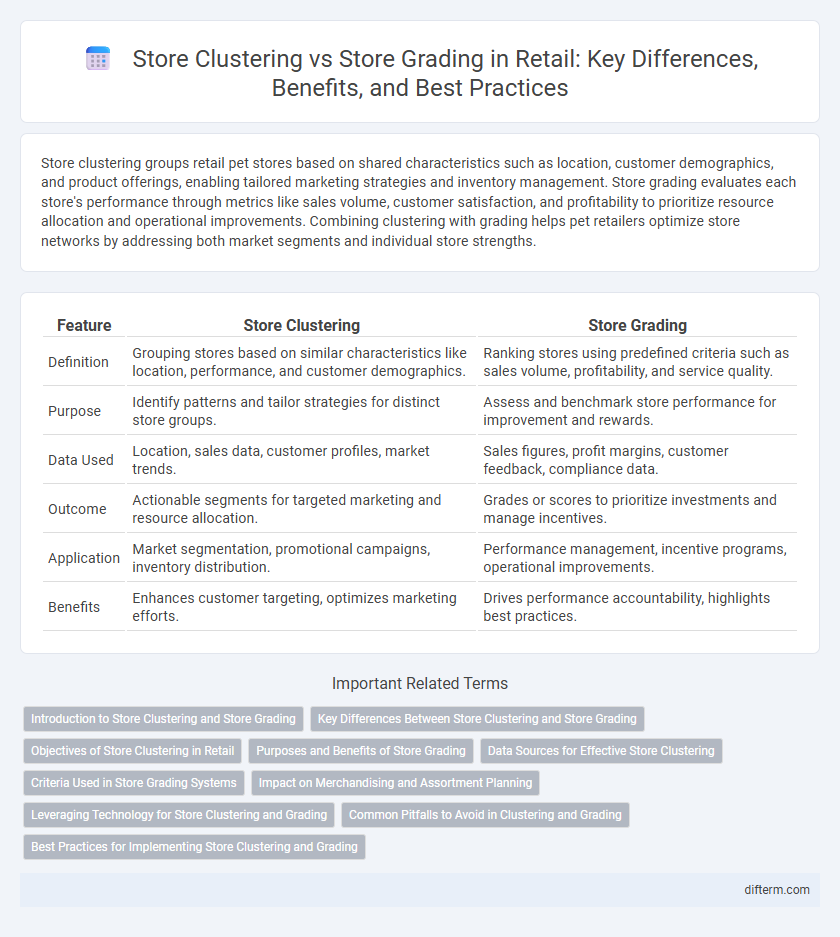Store clustering groups retail pet stores based on shared characteristics such as location, customer demographics, and product offerings, enabling tailored marketing strategies and inventory management. Store grading evaluates each store's performance through metrics like sales volume, customer satisfaction, and profitability to prioritize resource allocation and operational improvements. Combining clustering with grading helps pet retailers optimize store networks by addressing both market segments and individual store strengths.
Table of Comparison
| Feature | Store Clustering | Store Grading |
|---|---|---|
| Definition | Grouping stores based on similar characteristics like location, performance, and customer demographics. | Ranking stores using predefined criteria such as sales volume, profitability, and service quality. |
| Purpose | Identify patterns and tailor strategies for distinct store groups. | Assess and benchmark store performance for improvement and rewards. |
| Data Used | Location, sales data, customer profiles, market trends. | Sales figures, profit margins, customer feedback, compliance data. |
| Outcome | Actionable segments for targeted marketing and resource allocation. | Grades or scores to prioritize investments and manage incentives. |
| Application | Market segmentation, promotional campaigns, inventory distribution. | Performance management, incentive programs, operational improvements. |
| Benefits | Enhances customer targeting, optimizes marketing efforts. | Drives performance accountability, highlights best practices. |
Introduction to Store Clustering and Store Grading
Store clustering groups retail stores based on shared characteristics such as location, size, and customer demographics, enabling targeted marketing and inventory management. Store grading evaluates individual stores by assigning scores reflecting performance metrics like sales volume, customer satisfaction, and operational efficiency. Both strategies optimize retail operations by enhancing decision-making and resource allocation tailored to specific store profiles.
Key Differences Between Store Clustering and Store Grading
Store clustering groups stores based on similar characteristics such as location, customer demographics, and sales patterns to identify market segments and optimize marketing strategies. Store grading evaluates individual store performance using metrics like sales volume, profitability, and operational efficiency to rank stores and guide resource allocation. While clustering focuses on grouping for strategic targeting, grading emphasizes assessing and improving each store's competitive standing.
Objectives of Store Clustering in Retail
Store clustering in retail aims to group stores with similar sales patterns, customer demographics, and geographic characteristics to enable targeted marketing and inventory management. By identifying clusters, retailers can optimize store layouts, tailor promotions, and improve resource allocation. This approach supports strategic decision-making for expansion, product assortment, and localized customer engagement.
Purposes and Benefits of Store Grading
Store grading categorizes retail outlets based on performance metrics such as sales volume, customer traffic, and profitability, enabling targeted management strategies and resource allocation. It highlights high-performing stores for investment and low-performing outlets for improvement or closure, optimizing overall retail network efficiency. Store grading enhances decision-making accuracy, maximizes ROI, and supports tailored marketing campaigns aligned with specific store profiles.
Data Sources for Effective Store Clustering
Effective store clustering relies on diverse data sources such as point-of-sale (POS) transactions, customer demographics, geolocation data, and foot traffic analytics to group stores with similar performance and market characteristics. Incorporating external datasets like competitor presence, regional economic indicators, and social media sentiment enhances clustering accuracy by providing a holistic view of store environments. Unlike store grading, which primarily uses sales metrics to rank stores, clustering demands multidimensional data integration to enable targeted marketing strategies and optimized resource allocation.
Criteria Used in Store Grading Systems
Store grading systems evaluate individual retail outlets using criteria such as sales performance, customer footfall, profitability margins, and inventory turnover rates. These metrics enable retailers to classify stores into grades like A, B, or C, reflecting their operational efficiency and market potential. Unlike store clustering, which groups stores based on similar attributes for strategic alignment, store grading provides a hierarchical framework for performance benchmarking and resource allocation.
Impact on Merchandising and Assortment Planning
Store clustering groups retail outlets based on similar consumer behavior and location attributes to tailor merchandising strategies more effectively, enhancing assortment relevance and inventory turnover. Store grading evaluates individual store performance and customer demographics to prioritize resource allocation and customize product mixes, optimizing profitability and market responsiveness. Integrating both methods refines assortment planning by balancing broad market trends with specific store potential, driving improved sales and customer satisfaction.
Leveraging Technology for Store Clustering and Grading
Leveraging technology in retail enables advanced store clustering and grading through data analytics, machine learning, and geospatial analysis to optimize store performance and customer segmentation. Store clustering groups locations based on demographic, transactional, and behavioral data, enhancing targeted marketing and inventory management. Store grading assigns performance scores using sales metrics, foot traffic, and local competition, guiding resource allocation and strategic decision-making.
Common Pitfalls to Avoid in Clustering and Grading
Common pitfalls in store clustering include overreliance on limited data points, leading to inaccurate grouping that fails to capture customer behavior nuances. Store grading errors often stem from inconsistent performance metrics, which can skew results and impact decision-making. Ensuring comprehensive data integration and standardized evaluation criteria is essential to optimize retail store clustering and grading outcomes.
Best Practices for Implementing Store Clustering and Grading
Effective implementation of store clustering and grading requires leveraging detailed sales data, customer demographics, and regional market trends to create accurate and actionable store segments. Utilizing machine learning algorithms enhances the precision of clustering by identifying patterns that traditional methods may overlook, while grading stores based on key performance indicators like revenue, foot traffic, and customer satisfaction ensures prioritization of resources. Regularly updating clustering and grading criteria with real-time data allows retailers to adapt to shifting market conditions and optimize store strategies for maximum profitability.
Store Clustering vs Store Grading Infographic

 difterm.com
difterm.com